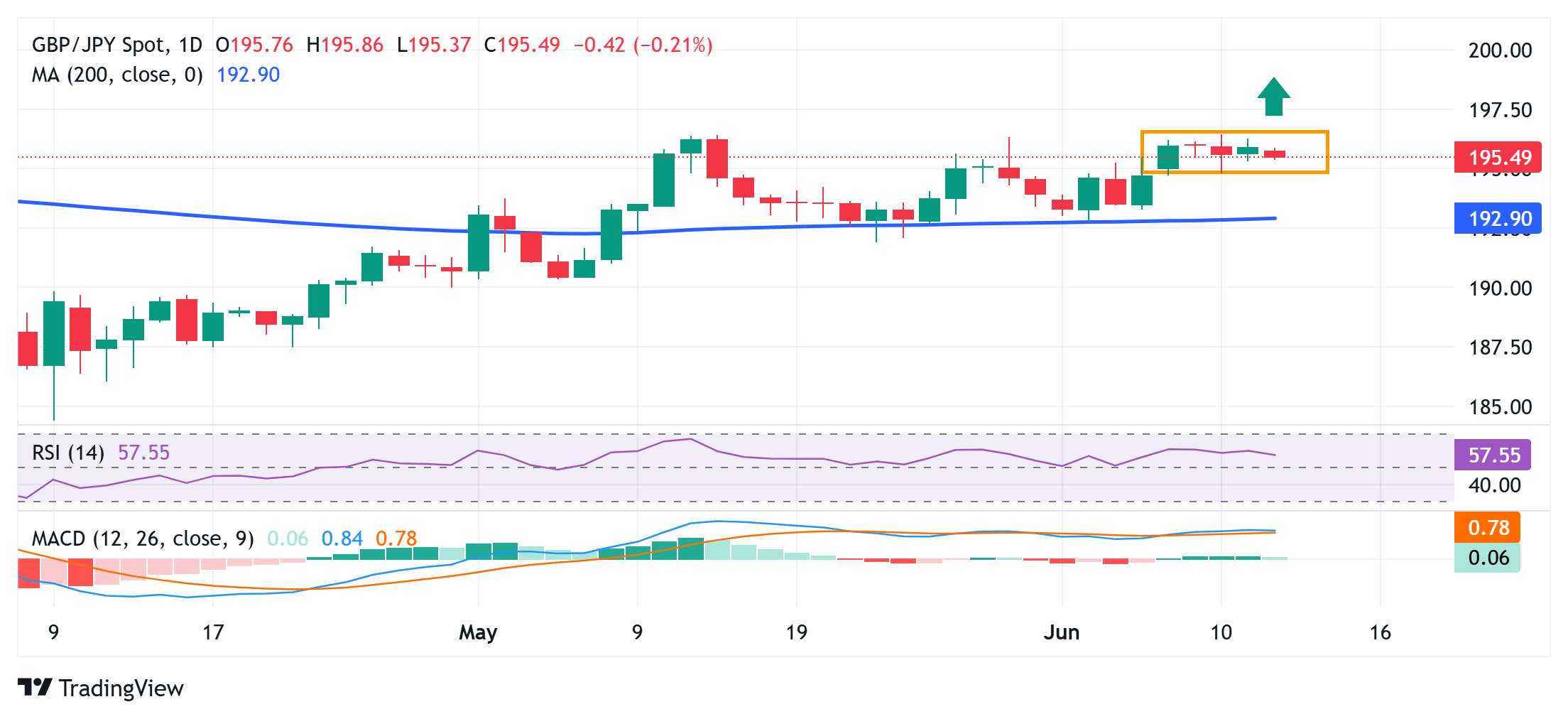GBP/JPY Price Forecast: Remains depressed near mid-195.00s ahead of UK monthly GDP
- GBP/JPY cross is pressured by a combination of factors, though it lacks follow-through selling.
- Reviving safe-haven demand and the divergent BoJ-BoE expectations weigh on spot prices.
- The technical setup backs the case for the emergence of some dip-buyers at lower levels.
The GBP/JPY cross struggles to capitalize on the previous day's modest gains and attracts fresh sellers during the Asian session on Thursday, though it lacks follow-through. Spot prices remain confined in the weekly range and currently trade around the 195.55 area, down 0.20% for the day as traders now look forward to the UK monthly GDP print for some meaningful impetus.
The Japanese Yen (JPY) strengthens across the board in reaction to US President Donald Trump's fresh tariff threat and rising geopolitical risks, which weighs on investors' sentiment and benefits traditional safe-haven assets. The British Pound (GBP), on the other hand, continues with its relative underperformance in the wake of bets that the Bank of England (BoE) will cut interest rates twice this year. This marks a significant divergence from expectations that the Bank of Japan (BoJ) would proceed with monetary tightening and suggests that the path of least resistance for the GBP/JPY cross is to the downside.
From a technical perspective, the range-bound price action might still be categorized as a bullion consolidation phase against the backdrop of the recent goodish rebound from the very important 200-day Simple Moving Average (SMA). Moreover, oscillators on the daily chart are holding comfortably in positive territory and are still away from being in the overbought zone. This, in turn, suggests that any subsequent slide to the 195.00 psychological mark is likely to attract dip-buyers, which should limit the downside for the GBP/JPY cross near the weekly swing low, around the 194.80-194.75 region, touched on Tuesday.
A convincing break below the latter, however, might prompt some technical selling and drag spot prices to the 194.00 round figure en route to the next relevant support near the 193.40 horizontal zone. The GBP/JPY cross could extend downward further and eventually drop below the 193.00 mark, to challenge the 200-day SMA, currently pegged near the 192.85-192.80 region.
On the flip side, the 195.85-196.00 area now seems to have emerged as an immediate barrier. This is followed by the May swing high, around the 196.25-196.30 region. A sustained strength beyond the latter could be seen as a fresh trigger for bulls and lift the GBP/JPY cross to the 197.00 mark for the first time since January. The momentum could extend towards the 197.40-197.50 hurdle en route to the 198.00 mark and the 198.25 region, or the year-to-date peak touched in January.
GBP/JPY daily chart

Japanese Yen FAQs
The Japanese Yen (JPY) is one of the world’s most traded currencies. Its value is broadly determined by the performance of the Japanese economy, but more specifically by the Bank of Japan’s policy, the differential between Japanese and US bond yields, or risk sentiment among traders, among other factors.
One of the Bank of Japan’s mandates is currency control, so its moves are key for the Yen. The BoJ has directly intervened in currency markets sometimes, generally to lower the value of the Yen, although it refrains from doing it often due to political concerns of its main trading partners. The BoJ ultra-loose monetary policy between 2013 and 2024 caused the Yen to depreciate against its main currency peers due to an increasing policy divergence between the Bank of Japan and other main central banks. More recently, the gradually unwinding of this ultra-loose policy has given some support to the Yen.
Over the last decade, the BoJ’s stance of sticking to ultra-loose monetary policy has led to a widening policy divergence with other central banks, particularly with the US Federal Reserve. This supported a widening of the differential between the 10-year US and Japanese bonds, which favored the US Dollar against the Japanese Yen. The BoJ decision in 2024 to gradually abandon the ultra-loose policy, coupled with interest-rate cuts in other major central banks, is narrowing this differential.
The Japanese Yen is often seen as a safe-haven investment. This means that in times of market stress, investors are more likely to put their money in the Japanese currency due to its supposed reliability and stability. Turbulent times are likely to strengthen the Yen’s value against other currencies seen as more risky to invest in.



